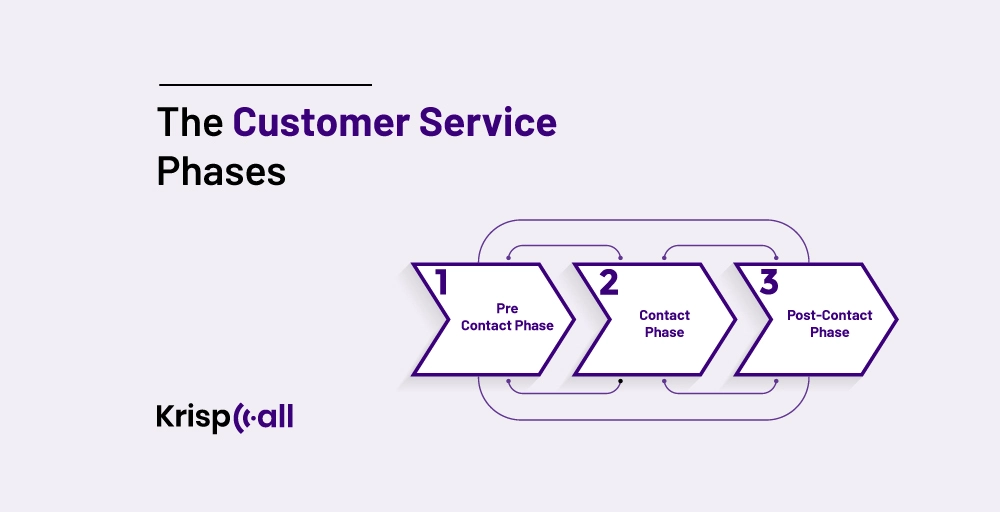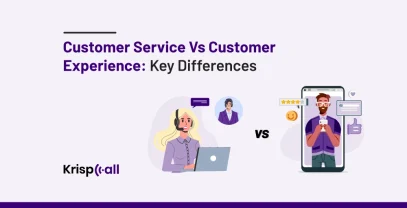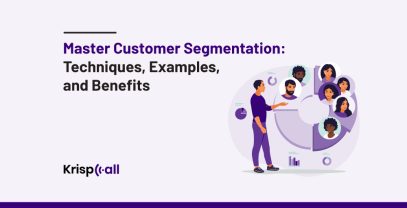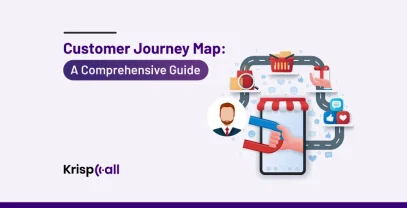Customer service is the backbone of a business’s ability to build an everlasting relationship with its audience. From growth to the brand’s reputation, it all comes down to how your customer service team operates. ✨
While many still believe customer service is simply taking customer complaint calls or emails, it has more depth. 📧 It may appear to be one of the simplest tasks on the surface, but there are many challenges, and one of the significant challenges of customer service is the process’s dynamic.
Customer service differs from brand to brand depending on various factors, like products and the transaction phase. While the ways of approaching clients/customers may depend upon the brand, the phases they must go through are almost the same.
Throughout the customer service process, these customer service phases are known to build healthy and everlasting relationships with leads.
🔑 KEY HIGHLIGHTS
- The three customer service phases include the pre-contact phase, the contact phase, and the post-contact phase.
- Some key components of the pre-contact phases are accessibility, self-service options, and website and online presence.
- To improve the contact phase, you must train agents properly, utilize technology, and personalize the experience.
- Depending on the brand, the post-contact phase can take various forms, such as short messages, surveys, and more, immediately or after a week.
Pre Contact Phase
Directly comforting customers via the customer service team is not the initial phase. How your business is represented to the public, its contact channels, and how it is discovered is the first phase of customer service.
The battle of offering proper customer service begins before you even know it. This phase always occurs before customers have purchased, asked questions, or called to complain about a service or product.
Some Key Components of the Pre-Contact Phase are as below:
- Accessibility: Offering a variety of communication channels, such as phone, email, and social media, makes it easy for customers to reach out to your brand. This closes the gap between you and your customer immensely.
- Website and online presence: An online store has become necessary today. It is one of the key components of the pre-contact phase that helps you spread your business worldwide. A user-friendly website with easy-to-navigate navigation, comprehensive FAQs, and a well-organized knowledge base makes it easy for customers to roam the website freely and easily.
- Self-service options: Offering self-service functions like live chat functionalities, chatbots, and informative demos makes things easier for customers and frees them from the hassle of directly contacting customer service.
Some Strategies to follow to improve Pre-Contact Phase:
- Make UX easy: One of the first things you should focus on is making your website and self-service options easy to navigate. Conduct user testing repeatedly to make any necessary changes to make it easy for customers to use.
- Engaging content: Creating and delivering high-quality content helps you express your brand information to customers in a fun way. One way to do this is by frequently updating FAQs and product descriptions with clear information.
- Identify your customer: Identifying the type of customer your business serves is necessary as it helps you set guidelines for the language, videos, and content you’ll share with them.
Contact Phase
After overcoming the first phase of the Pre-Contact Phase, the second phase, the Contact Phase, started. In this phase, customers make their first (or repeated) contact with a company via customer service or support team.
This phase must be performed with utmost responsibility as it will be one of the biggest factors influencing customer decisions. This phase can help you build a strong bond with your customers.
Throughout the process, the Pre-Contact Phase helps you create a zone for your customers to learn more about your business, while the contact phase helps you set the right tone with your customers.
Some Key components of the Contact Phase:
- First Tone: How you greet your customer sets the rhythm and tone for the entire interaction. With a proper greeting, the conversation is bound to continue smoothly and meaningfully.
- Empathy: Customer service representatives must actively listen to customer concerns without interruption. While listening to what customers say, they should demonstrate empathy statements by acknowledging their frustration and making them feel you are there for them.
- Effective Communication: Maintaining clear and professional communication is essential to make it comfortable for customers to express their queries comfortably. Seamless communication can heavily impact the relationship between any brand and its audience.
Some Strategies to improve the Contact Phase:
- Proper training: Proper training is necessary in every line of work, and customer service is no exception. Comprehensive training programs will help your representative team respond to inquiries with the right words and tone.
- Utilize technology: Utilizing the latest technologies helps your team to track customer interactions and chat history. With this valuable information, you can improve or change the way you approach any particular customer in the future.
- Personalize experience: Every customer calls customer support with different moods and queries. So, adapting and adjusting to the needs of specific customers is necessary. By adapting to the questions, your customers’ answering in the right tone and matching their energy will surely offer positive results.
Post-Contact Phase
The post-contact phase is about helping your brand build long-lasting relationships and the necessary base for the future. This phase begins once the customer contacts your customer service team.
The Post-Contact Phase can occur immediately or even after several weeks or months have passed, and depending on the brand, it can take various forms, such as short messages, surveys, and more.
This phase helps your brand ensure customer satisfaction, identify any remaining issues or concerns, and solidify positive impressions of the company.
Some Key Components of the Post-Contact phase:
- Follow-up: Following up after an issue has been resolved is one way to build a positive image within your audience. The primary way of following up with your customers is to send a confirmation email thanking them for contacting you.
- Feedback: Asking for feedback demonstrates sincerity and transparency in your customer service approach. Moreover, it lets you gain insights into your customer service process and implement necessary improvements.
- Relationship building: Don’t just settle for resolving the issue. Utilize this opportunity to learn more about the customer’s needs and preferences. This can make things easy for future interactions and promote products and services.
Some Strategies to improve the Post-contact Phase:
- Be thankful to the customer: A simple thank you can show the customer that you appreciate their business. Thanking the customer is not just limited to the phone. You can always express your thankfulness via mail, gift cards, or even in person.
- Gather feedback: After interacting with the customer, always ask for feedback on their experience. This information can play an important role in the future of your brand. You can always look for ways to gather feedback, such as a survey, email, or phone call.
- Provide additional resources: Always be ready to offer customers any additional help. In need, provide them with resources such as a knowledge base article, FAQ section, or contact information for technical support.
Conclusion
The customer service process is the heartbeat of any successful business, directly impacting the customer experience and shaping the long-term relationship between a company and its clients.
Understanding and implementing pre-contact, contact, and post-contact phases of customer service will help you increase customer loyalty, boost revenue, and gain a competitive advantage in the marketplace.
With these three phases being interconnected with each other, focusing only on one of them may not deliver you the result you are looking for. Focus on all these phases while following the key components & strategies, and let your business experience the change.
FAQs
What are the main elements of customer service?
Some of the main elements of excellent customer service are:
- Speediness and Promptness
- Quality and Efficiency
- Empathy and Understanding
- Accessibility and Availability
- Clear Communication and Expertise
What are the emerging trends for shaping the future of customer service?
The emerging trends shaping the future of customer service include:
- Automation, AI, and Machine learning
- Omnichannel Approach
- 5G and Immersive Technologies
- Data-driven Insights
Why customer service is important in business?
Customer service is the lifeblood of any business. It’s the direct line connecting you and your customers, shaping their perception of your brand and impacting their decision to make repeat purchases. Customer service helps businesses to build customer loyalty, boost sales and revenue, and many more.





